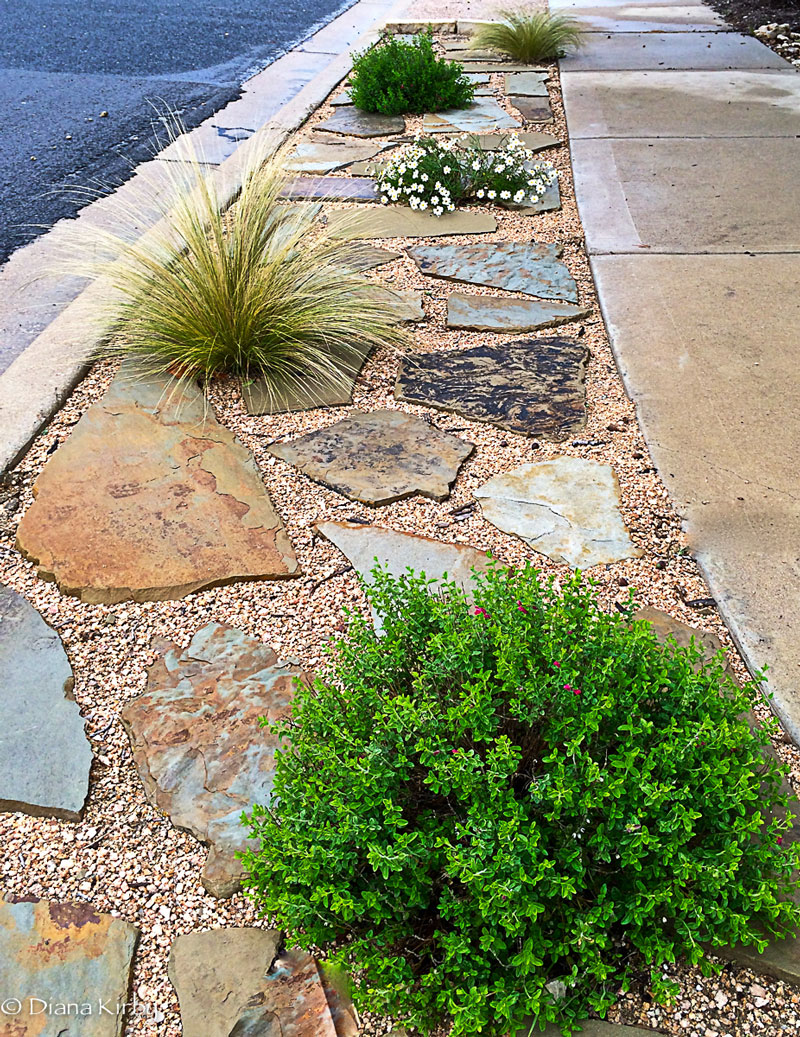Let’s talk about sidewalk strips. You know, that slimmest sliver of dry, cracked soil between the street curb and your sidewalk. Where grass just won’t grow, no matter how hard you try.
 Erratic rains, then drought, and foot traffic all take their toll on these tiny pieces of turf. Alternating between crispy brown grass, dusty dirt, or tattered weeds, these hot spots often bake like an entrée in an oven in the hottest stretches of summer.
Erratic rains, then drought, and foot traffic all take their toll on these tiny pieces of turf. Alternating between crispy brown grass, dusty dirt, or tattered weeds, these hot spots often bake like an entrée in an oven in the hottest stretches of summer.
Watering grass in these strips is a challenge, and usually results either under-watering grass or wastefully over-watering sidewalks and pavement.
While it may be one of the toughest spots in which to grow grass, it’s also the very first impression your guests will have of your home. Imagine visiting with neighbors over a flowing flowerbed, or children watching hummingbirds light on pollinator-friendly plants. Or, if your family or friends often park along this area, wouldn’t it be nice to have a place for them to step out of their vehicles without wearing a footpath in your grass?
So, how do you create curb appeal in a challenging sidewalk strip?
First, assess your use patterns. Will people park there often and want to step out onto the strip? Will kids ride their bikes on the sidewalk and veer into that area repeatedly? Perhaps neighbors walk their dogs along the sidewalk, strategically turning the other way when Fido finds the perfect spot right on your struggling grass?
Would you like a pop of plant color that beckons visitors into your garden? Or do you prefer the structure of native grasses or agaves? Are you looking for seasonal interest all year long?
Do you fantasize of pouring concrete there so that you can spend less time watering in the heat? Perhaps you can think of better ways to spend your money than your astronomical water bill?
Fortunately, there are many creative options, depending on your particular taste.
If your forlorn sidewalk strip remains safe from pedestrians and kids, you might consider removing the grass entirely, adding some good garden soil, and creating a ribbon of tough, drought-tolerant, low-profile native and adapted plants. Choose plants best suited for the space; assess the amount of sun or shade they will receive and how much you will water.
Make sure you know how big your plants will get, and believe the labels. You don’t want your next problem to be searching for a machete to cut back an overgrown, tangled monster that threatens to take your sidewalk hostage.
Blackfoot daisy, Mexican feather grass, Queen Victoria agave, pink or purple skullcap, damianita, zexmenia, catmint, evening primrose and euphorbia would all make good water-wise choices for a small space.
Looking for a low to no-maintenance, yet attractive solution for a higher-traffic strip? Forget the concrete and consider creating a patio-like ribbon with your favorite flagstone and some decomposed granite. You can also add just a few water-wise plants to add interest, yet retain enough space for friends to step out of their cars.
Whether you’re looking for a pop of native curb appeal color or want to simplify your space,
there are many creative plant and hardscape options if you want to ditch the turf in your sidewalk strip.


I love the look in this photo. I am new to gardening and owning a home. What are those plants in the photo.
I love what you did in this photo.Very creative…what are the larger flat stones you used..Appreciate your reply.Thank you…